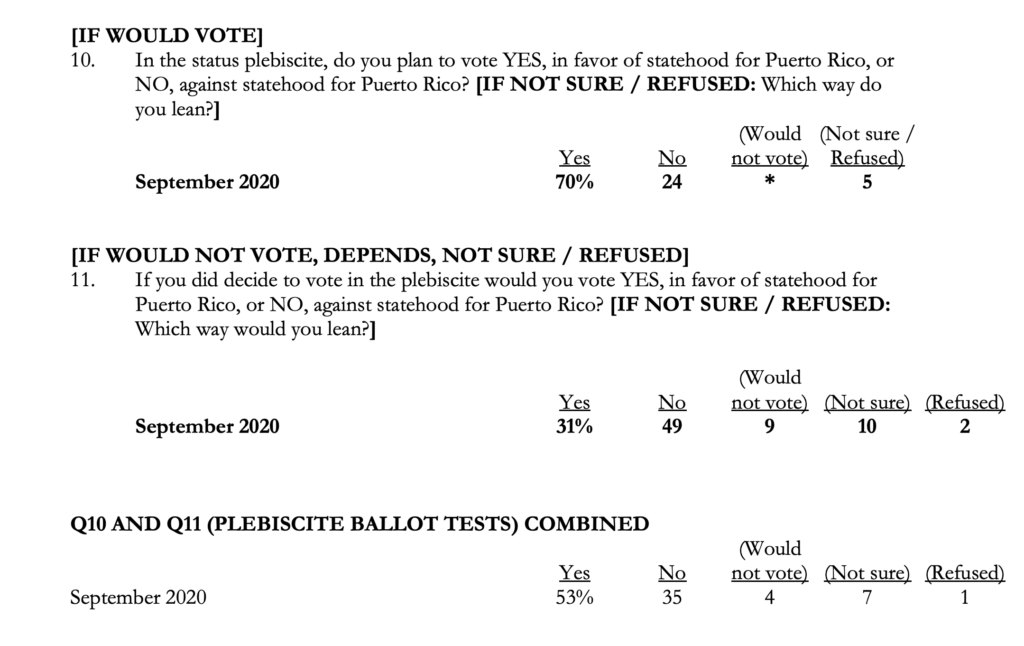The President’s Task Force on Puerto Rico mandated that there would be a consultation of the views of the people living in Puerto Rico to find out their views on their status. This must happen at least every ten years. There will be a new status vote on November 3rd, asking Puerto Rico voters to say “yes” or “no” to statehood.
The last time there was a status referendum in Puerto Rico was in 2017, when 97% of the voters chose statehood from the possible alternatives outlined by the U.S. Department of Justice. Turnout was low — 23% — but many U.S. elections are decided by fewer than 23% of the eligible voters. Turnout literally makes no difference in American elections. However, the anti-statehood parties had called for a boycott of the vote.
Nobody calls for a boycott of a vote they can win
The current territorial option was on the ballot. Independence was on the ballot. But statehood is the most popular status on the Island. Both the “commonwealth” party (which cannot put their “enhanced commonwealth” on the ballot because the federal government has declared it unconstitutional) and the independence party knew they would lose. Their solution was to call for a boycott of the vote.
They had already succeeded in discrediting the 2012 vote, in which more than 60% of voters chose statehood, by claiming that all blank ballots were votes for their cause. If they could claim that every potential voter who didn’t vote was in fact making a statement in their favor, they could pretend that they won.
That was the plan, and they had some success. For members of Congress, at least, the ruse made it seem as though Puerto Ricans just weren’t sure what they wanted. “If they want statehood, they can have it,” many politicians said. “We’re just not sure that they want it.”
Statehood continues to be the most popular option
A recent survey by Beacon found that 70% of probable voters preferred statehood. Among those who did not plan to vote, 31% still chose statehood, but 49% did not. By combining the two questions, the researchers found that 53% — a clear majority — supported statehood and 35% did not.
We confidently expect that statehood will win in 2020, too.
None of the above
In 1998, a referendum was held which saw statehood receive 46.5% of the vote, independence garner 2.5%, and commonwealth and free association both get less than 1% of the vote. It was clear which of the viable options was the most popular.
However, 50.2% of voters chose “None of the above.” There were a number of different interpretations of this vote at the time, but the controversy again came down to the desire of the “commonwealth” party to include their definition of “commonwealth” on the ballot. The federal government, then as now, rejected that definition of “commonwealth.”
“Commonwealth” has no legal meaning in the United States. Puerto Rico is an unincorporated territory of the United States.
“None of the above” essentially put a boycott option on the ballot.
The 2020 plebiscite
This time, on November 3rd, Puerto Rico voters will have a clear choice. Those who want statehood can vote YES. Those who do not want statehood can choose NO.
In 2017, some statehood supporters chose not to vote. A survey by El Vocero found that some feel that their vote didn’t matter — statehood was obviously winning. These voters unintentionally joined the boycott. Statehood opponents claimed their votes.
Don’t let that happen again. If you live in Puerto Rico, make sure that you vote, and encourage your friends and family to do the same. If you live in a state, be ready to contact your legislators to support the vote. Let your friends and family in Puerto Rico know that you’ve got their back, and that you’re counting on them to vote.
Let’s make some history.








No responses yet